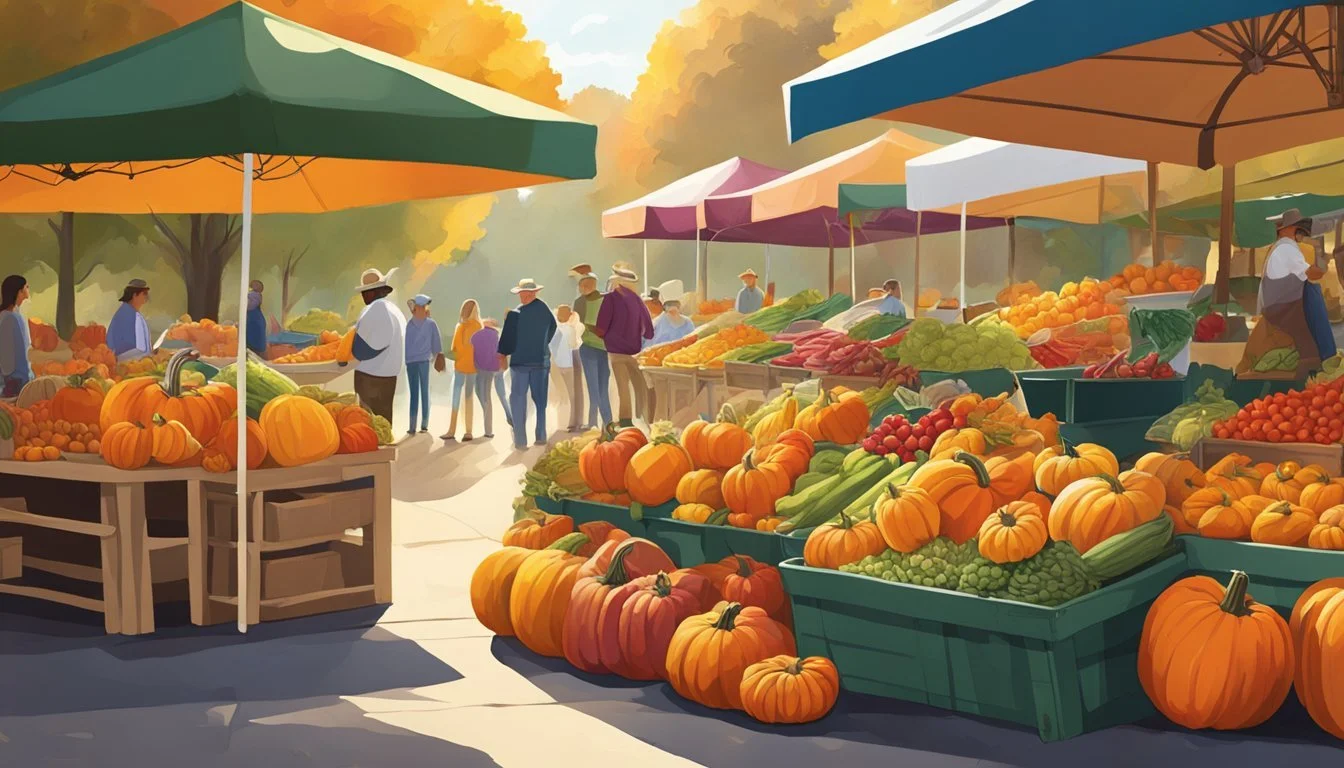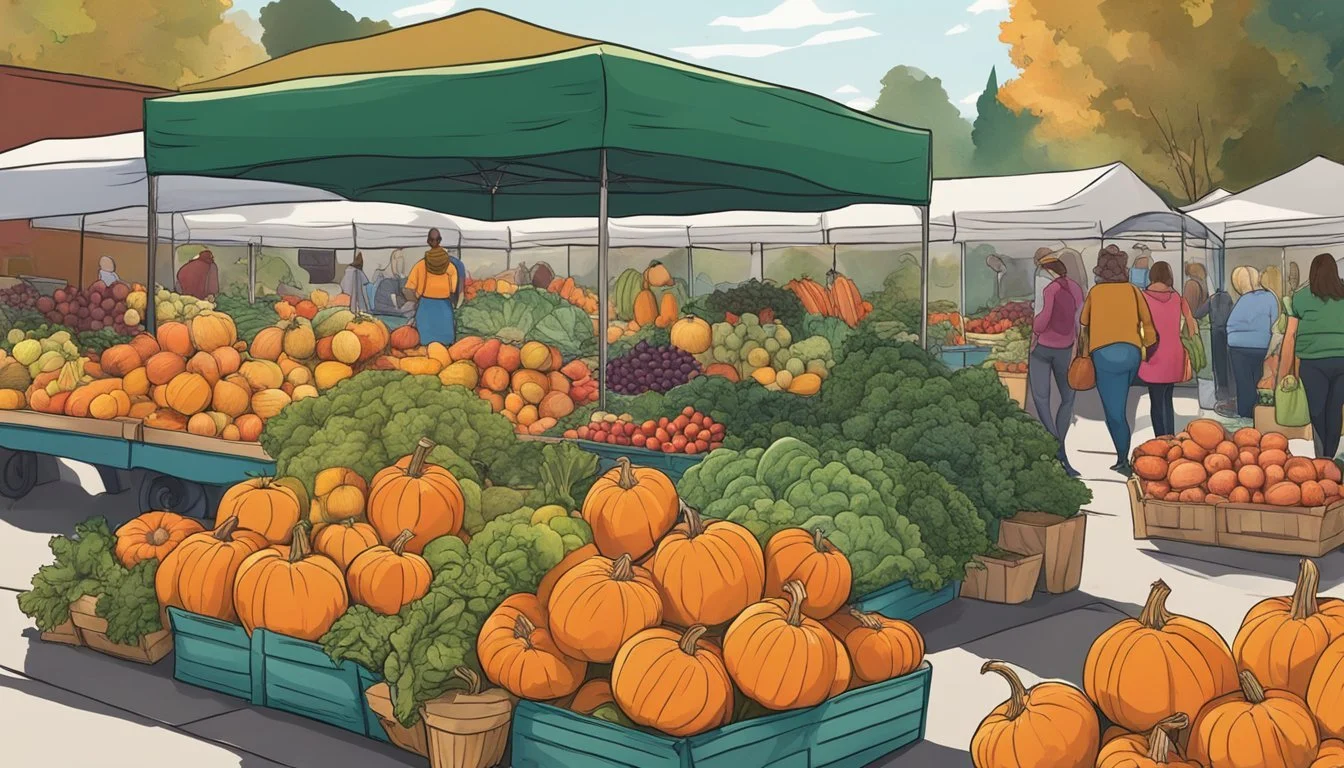North Carolina Seasonal Fruit & Vegetables in October
A Guide to Autumn Harvest
This Article is Part of our North Carolina Seasonal Fruit & Veg Calendar
October in North Carolina showcases a rich tapestry of produce as the state transitions from summer's bounty into the heartier selections of fall. During this month, the harvest continues with a variety of fruits and vegetables that encapsulate the essence of autumnal flavors. Farmers' markets and grocery stores across the state are replenished with fresh, locally-grown options that support a sustainable lifestyle and celebrate the seasonal cycle of agriculture.
Among the plethora of produce available, October marks the presence of cauliflower (how long does cauliflower last?), offering its versatile use in dishes from creamy soups to roasted sides. Root vegetables like celeriac emerge as a staple for hearty meals, while leafy greens such as collard greens (how long do collard greens last?) persist through the cooler weather, providing essential nutrients. Meanwhile, the sweet and tart flavors of the season can be savored in the last cherries and the beginning of apple varieties, which are historically prominent in North Carolina's agricultural offerings.
As a state with a robust agricultural sector, North Carolina takes pride in its seasonal produce which not only nourishes but also provides an opportunity for consumers to connect with the local food system. By choosing fruits and vegetables that are in season, consumers can enjoy the peak of freshness and flavor while supporting regional farmers and reducing the environmental impact that comes with long-distance food transportation.
Optimal Seasonal Eating
In North Carolina, eating seasonally in October means indulging in the bounty of fall's harvest. October, the heart of the fall season, is an ideal time for consumers to find freshness in a variety of produce, ensuring vibrant flavors and nutritious benefits.
What to Look For:
Fruits:
Apples — an autumn staple perfect for pies, cider, and snacks
Muscadine Grapes — sweet and robust, ideal for fresh eating or jellies
Pears — delicately sweet, excellent for baking and preserves
Blackberries — late-season berries are sweeter
Opt for these vegetables:
Vegetables:
Pumpkin — synonymous with fall, versatile in both sweet and savory dishes
Sweet Potatoes (What wine goes well with sweet potatoes?) — rich and hearty, a fall favorite for roasting or casseroles
Butternut Squash (how long does butternut squash last?) — creamy and substantial, perfect for soups and pasta
Collard Greens — robust greens that pair well with heartier meals
Turnips — earthy and mild, can be roasted or mashed
During October in North Carolina, farmers' markets and grocery stores brim with these seasonal items. Consumers are encouraged to support local agriculture which often results in meals that are not only tastier but are environmentally considerate due to reduced transportation impacts. When one eats seasonally, they also align with the natural harvest cycles, often leading to more affordable prices for peak produce.
Remember to seek out these seasonal offerings for an optimal dietary experience that celebrates the fall season with every bite.
Seasonal Produce Overview
During October in North Carolina, the transition from the warm summer months to the cooler days of fall brings a variety of in-season produce that is both flavorful and nutritious. Consumers can take advantage of the seasonal harvest that includes a wide range of fruits and vegetables.
Fruits peaking during this month have a rich flavor profile. Apples, a fall favorite, come in numerous varieties like Crispin, Braeburn, and Fuji, making them perfect for both eating fresh and cooking. In the realm of berries, the tail end of muscadine grape season offers a local treat well-suited for jellies, juices, and wine-making.
The vegetable selection in October is equally diverse. Leafy greens such as collards are abundant and are a staple in southern cuisine. Root crops, such as radishes and beets (how long do beets last?), are also plentiful. These earthy veggies are ideal for roasting or adding a crunchy element to salads. Additionally, numerous cruciferous vegetables like cauliflower and cabbage are available, excellent for heartier meals.
Availability of Key Produce in October:
Fruits:
Apples: Various types
Muscadine Grapes
Vegetables:
Collards
Radishes
Beets
Cauliflower
Cabbage
For those who prefer to buy locally and support North Carolina's farmers, visiting farmers' markets or farm stands can yield the freshest selections of produce. These markets provide seasonal varieties that are often harvested at their peak, ensuring maximum flavor and nutritional benefits.
Fruit Harvest in October
In North Carolina, October ushers in a variety of fruits ready for harvest, featuring both tender, sweet flavors and firmer, tart varieties.
Sweet and Juicy Picks
During October, the fruit harvest is plentiful with sweet and juicy options. Persimmons are a notable fruit during this time, presenting a honey-like flavor when fully ripe. They are often enjoyed fresh or used in desserts and jams. Sweet potatoes, while not a typical 'fruit', take on a sweet profile and are a versatile choice for both savory and sweet dishes. Figs, rich and decadent, come into season, offering their unique flavor to the autumn palette.
Persimmons: Honeyed and soft.
Sweet Potatoes: Naturally sweet and hearty.
Figs: Lusciously sweet and versatile in use.
Crunchy and Crisp Selections
October also brings crunchy and crisp fruits to the table. Apples abound in a variety of species, each with its unique taste and texture—perfect for eating fresh or baking into pies. Pears appear in the markets, with their delicate flavor and refreshingly crisp bite ideal for both raw and cooked applications.
Apples: Varied and versatile.
Pears: Delicately sweet and crunchy.
Vegetable Bounty of October
In October, North Carolina's harvest offers a rich variety of vegetables, with leafy greens and cruciferous types reaching peak season, alongside a diverse array of root vegetables and gourds.
Leafy Greens and Cruciferous Vegetables
Kale and Spinach: These leafy greens thrive in the cooler temperatures of October in North Carolina, offering a nutritious addition to meals. Kale and spinach are versatile and can be enjoyed raw or cooked.
Broccoli and Cabbage: The fall climate also supports the growth of broccoli and cabbage, with their harvests being particularly vibrant during this month. Both vegetables are known for their health benefits and can be prepared in numerous ways.
Collards: A southern staple, collards are at their best in October, providing a hearty flavor to traditional dishes.
Root Vegetables and Gourds
Sweet Corn and Potatoes: Sweet corn and potatoes continue to be harvested into October, though the end of their season is approaching. These staples offer a comforting presence in autumnal meals.
Turnips and Radishes: Root vegetables like turnips and radishes are harvested in October, bringing a peppery or pungent kick to the plate.
Winter Squash, Butternut, and Pumpkins: Gourds, including winter squash, butternut, and pumpkins, are in abundance. These offer a sweet and nutty taste that is perfect for fall recipes.
Carrots and Beets (how long do beets last?): Carrots and beets, with their deep colors and sweet flavors, are also gathered during this time, perfect for roasting or as additions to salads.
Onions: October is a time when onions come into full season, ready to add flavor depth to any dish.
Herbs and Other Specialties
In North Carolina, October is a month where chefs and homesteaders celebrate the availability of an array of herbs and other distinctive produce. Below is a closer look at the typical offerings during this autumnal period.
Herbs:
Cilantro: It thrives almost year-round, but October is included in its growth cycle, providing a fresh, citrusy flavor for a variety of dishes.
Dill (how long does dill last?): Known for its feathery fronds and unique aroma, dill is often harvested in the cooler beginnings of fall.
Specialties:
Garlic: By October, garlic has been harvested and cured, ready to be used for its pungent and beloved flavor. North Carolina's climate allows garlic to develop strong roots and bulbs, contributing to its robust taste.
Ginger: Although not as common, ginger can be found in October, bringing its spicy and warming qualities to the table.
Herb Uses and Pairings:
Herb Uses Pairings Cilantro Salsas, salads, marinades Tomatoes, avocados, citrus Dill Seafood dishes, (What wine goes well with seafood dishes?) pickling, dressings Fish, cucumbers, yogurt Garlic Sautéing, roasting, sauces Practically every savory dish Ginger Baking, stir-frying, teas Pears, carrots, sweet potatoes
These herbs and specialties offer a myriad of flavors dominating the culinary scene in fall. They are integral for cooks looking to prepare seasonally appropriate and flavorful meals.
Preparing Seasonal Produce
Choosing the right preparation method can enhance the natural flavors of North Carolina's seasonal produce. October's bounty offers a variety of fruits and vegetables that can be transformed into delightful dishes through various cooking techniques and recipe ideas.
Cooking Techniques
The key to maximizing the freshness of October's produce is using appropriate cooking methods that preserve their natural flavors and nutrients:
Roasted: Cauliflower and sweet potatoes develop a sweet, caramelized exterior when roasted in the oven, which accentuates their natural sugars.
Steamed: Collard greens and swiss chard, being full of vitamins, are best steamed to retain their nutritional value and vibrant color.
Braised: Root vegetables like celeriac can be braised to draw out their earthiness while creating a tender texture.
Recipe Ideas
Finding inspiration for recipes can turn fresh October produce into star dishes. Below are ideas that one can explore:
Salad: A crisp salad incorporating raw chard, thinly sliced apples, and a selection of other seasonal raw vegetables delivers a refreshing crunch.
Oven-Baked Dishes: Sweet potatoes can be sliced and layered in a gratin or cut into wedges and baked to make a comforting side dish.
By selecting the right techniques and recipes, one can honor the peak freshness and flavors of North Carolina's October harvest.
Benefits of Seasonal Eating
Eating seasonally provides various advantages that resonate with health, ecology, and taste. When consumers choose seasonal fruits and vegetables, they are often rewarded with food that is richer in flavor and nutrients. October’s seasonal produce in North Carolina is no exception, providing an array of colorful, nutritional options that are both high in fiber and bursting with natural taste.
Nutritional Superiority: Seasonal fruits and vegetables tend to be fresher and have the optimal nutrient profile. They have been allowed to ripen fully in the sun, a process which naturally enhances a product's flavor and nutritional value. For instance, Brussels sprouts (how long do brussels sprouts last?)and pumpkins that are picked during their fall peak are likely to contain more vitamins and fiber compared to those harvested out of season.
Environmental Benefits: Local, seasonal produce has a lower environmental impact. It typically requires less transportation and storage, thus reducing its carbon footprint. This eco-friendly way of eating encourages a more sustainable food system.
Table 1: Nutrient Content of Select Seasonal Produce in North Carolina
Produce Peak Season Notable Nutrients Brussels sprouts October - December Vitamins K, C, and Fiber Pumpkins October - December Vitamins A, C, and Fiber Apples October Fiber, Vitamin C
Lastly, the consumption of fruits and vegetables within their season supports local economies. It benefits the local farmers who work hard to grow produce specific to the region and season. Consumers directly contribute to their community, fostering a connection between the farm and the dinner table.
Where to Find October's Harvest
In October, North Carolina's harvest brings a variety of fresh produce to local communities. At this time of year, shoppers can discover a diverse selection of fruits and vegetables grown within the region.
Local Farmers Markets
Farmers markets across North Carolina are abundant with October's fresh harvest. Shoppers can find apples, pumpkins, and sweet potatoes among other seasonal produce. These markets not only offer a place to purchase fresh goods but also provide an opportunity to support local farmers directly. Key venues where one can experience these local offerings include:
Charlotte Regional Farmers Market
Raleigh State Farmers Market
Asheville City Market
Each market showcases a slice of the area's agricultural variety, with vendors who typically have a deep knowledge of their produce.
Community Supported Agriculture (CSA)
Community Supported Agriculture programs in North Carolina offer another avenue for sourcing October's harvest. Through CSAs, consumers can subscribe to receive a share of fresh produce directly from local farms. This exchange bolsters the local economy and fosters a closer buyer-farmer relationship. Notable CSA programs offering October produce include:
Piedmont Biofarm CSA
Gaining Ground Farm CSA
Joining a CSA often requires a subscription ahead of the season, but it guarantees a regular supply of fresh, locally cultivated fruits and vegetables throughout the harvest months.








